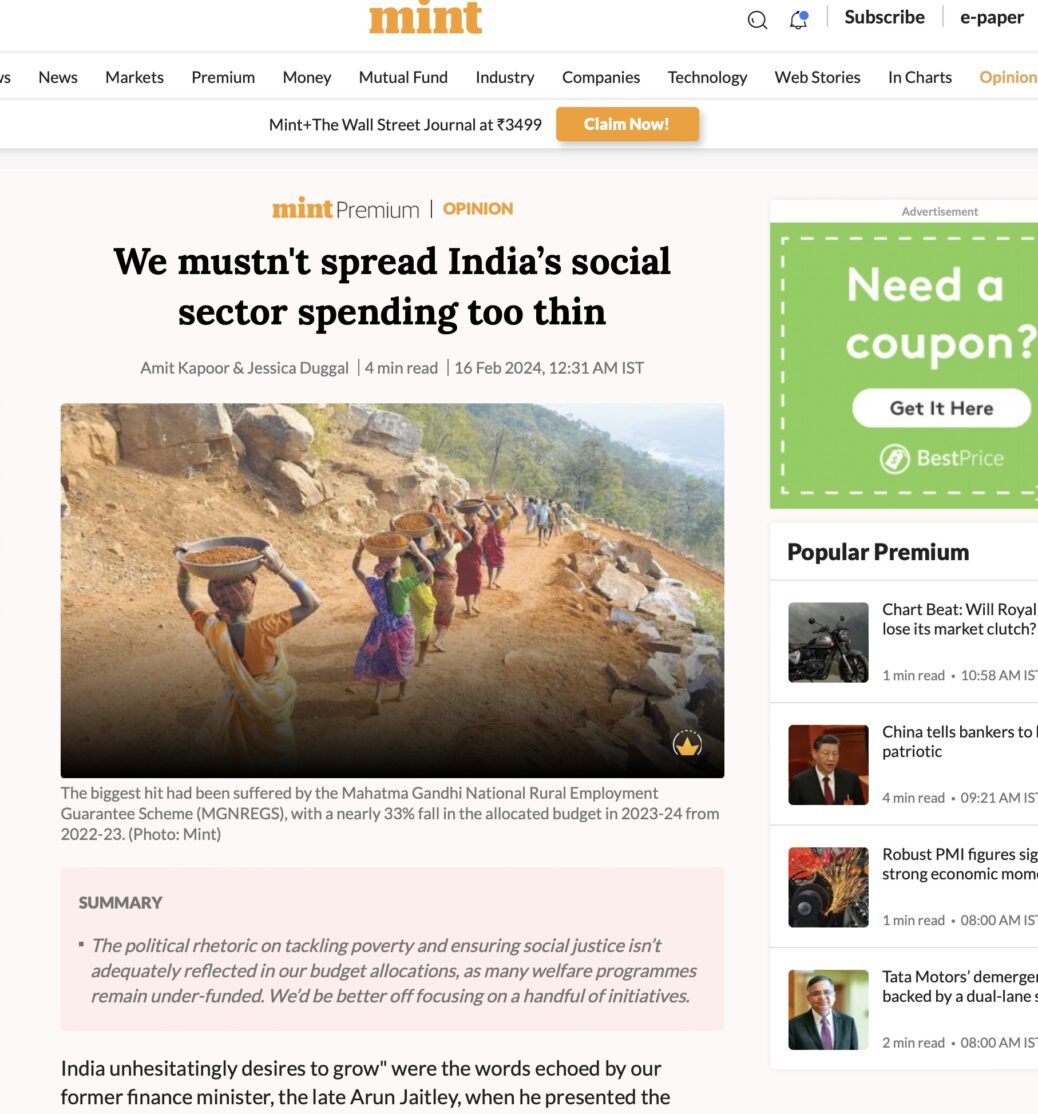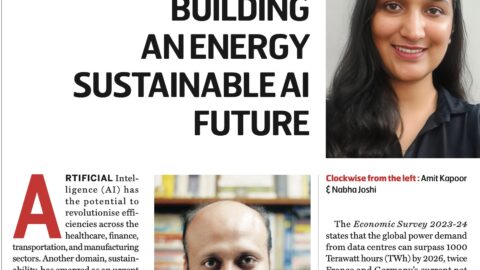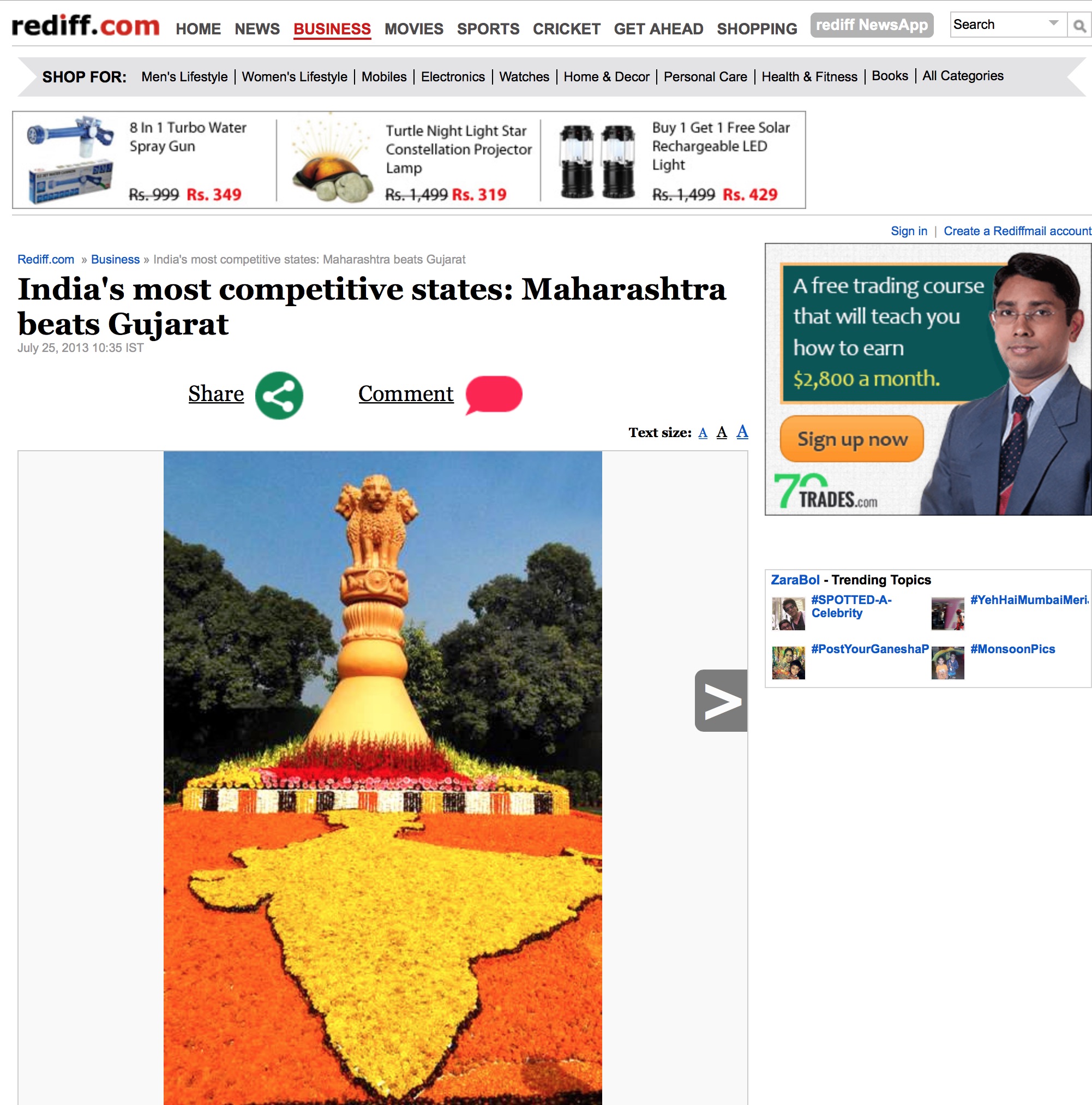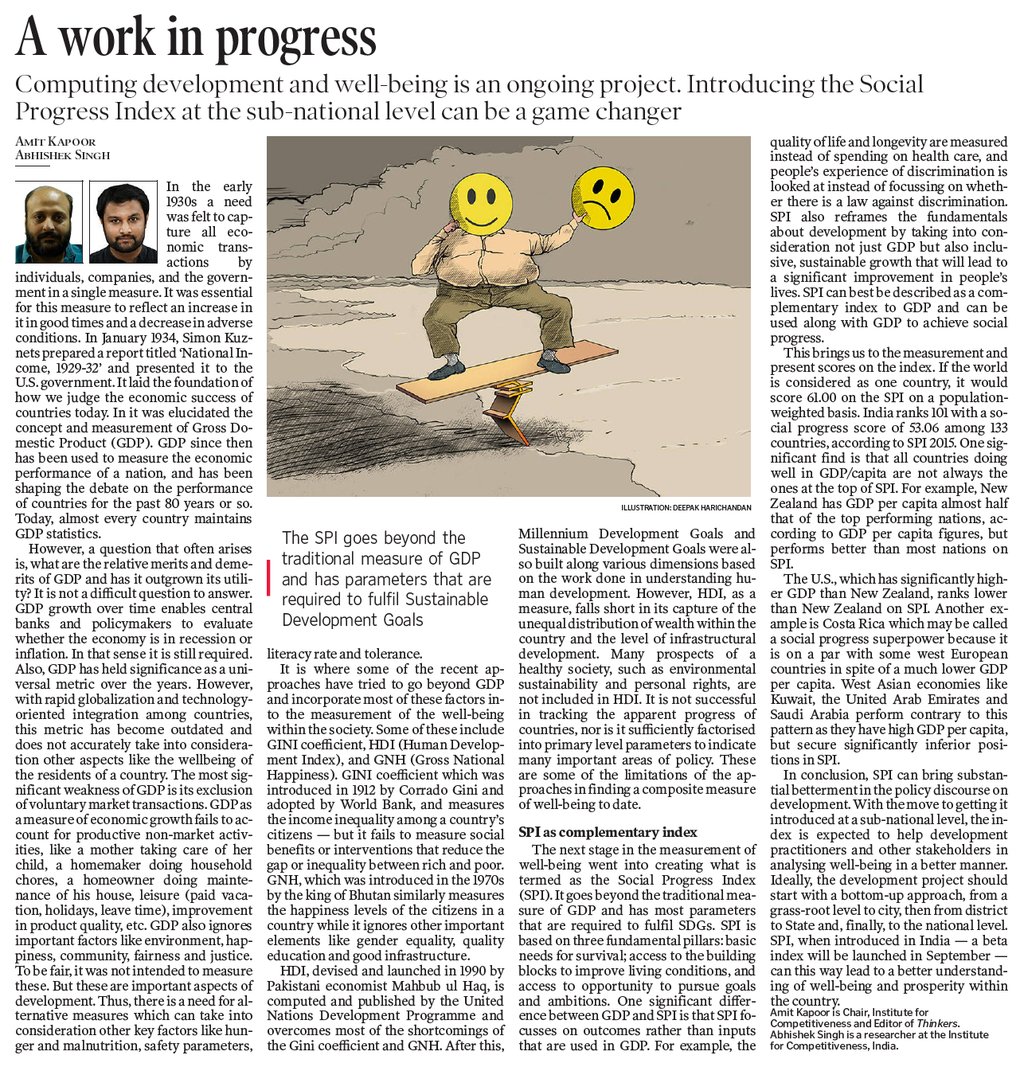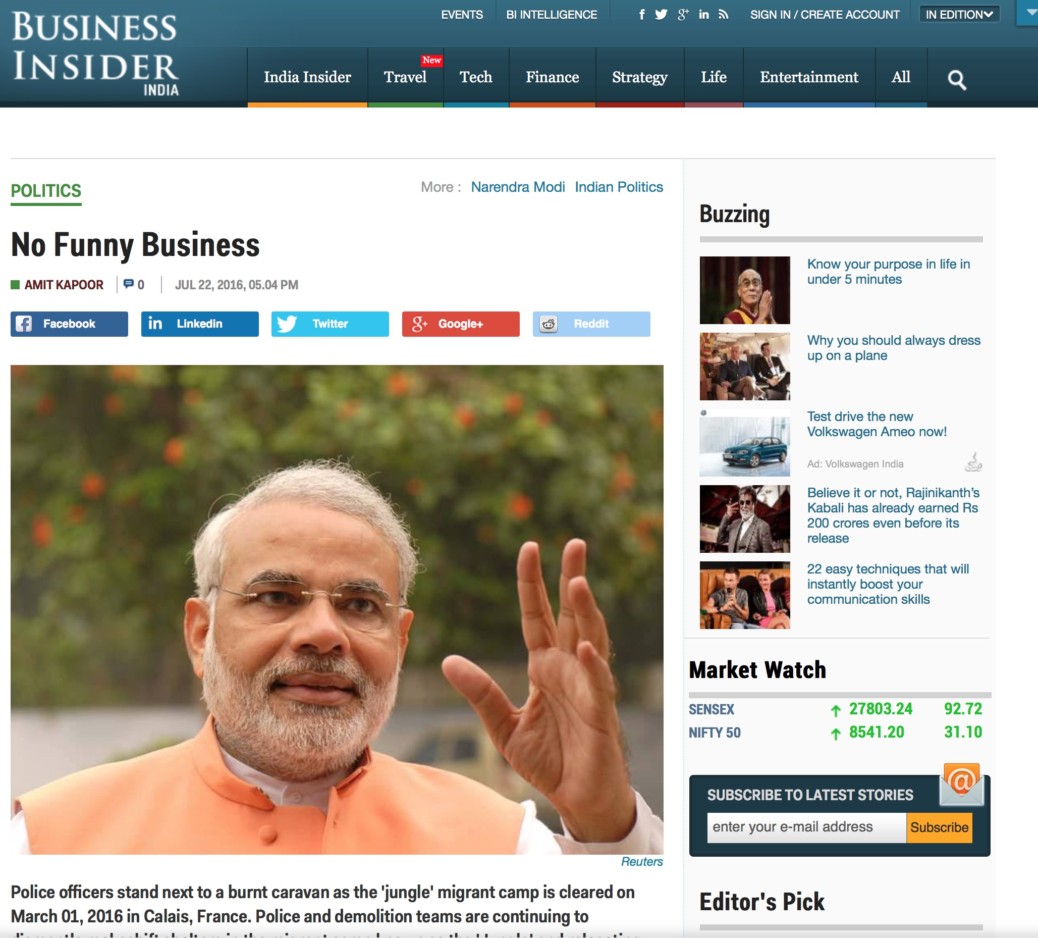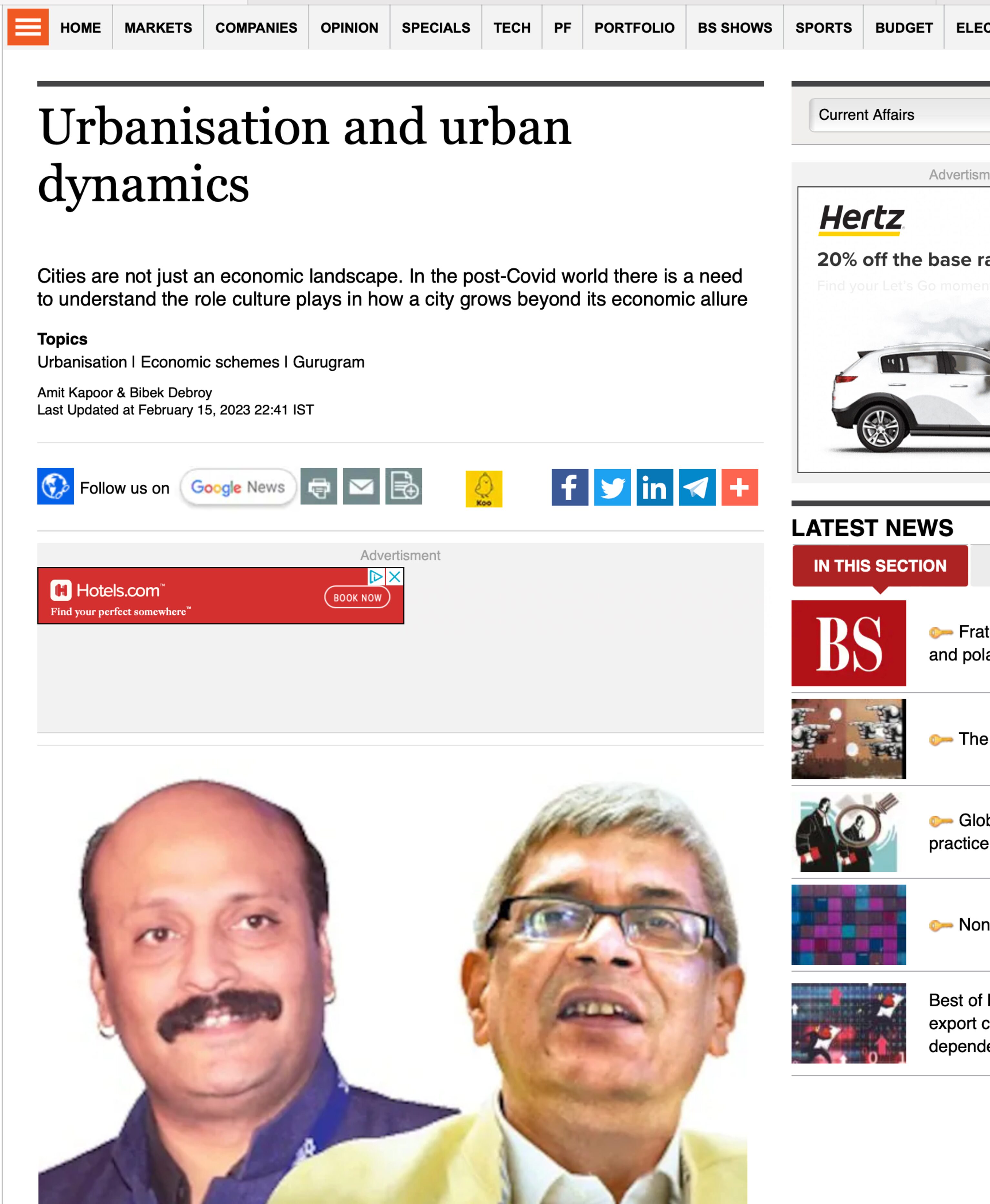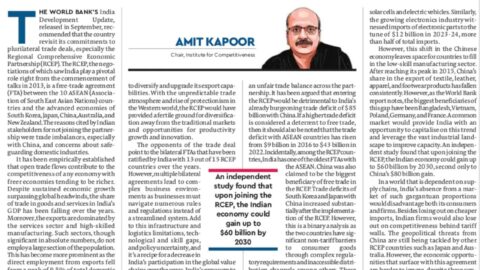What Does India’s Social Sector Spending Look Like?
by Amit Kapoor and Jessica Duggal
“India unhesitatingly desires to grow” were the words echoed by our former finance minister, Late Arun Jaitely, as he presented the first union budget of the Modi government a decade ago. The focus conspicuously remained on poverty reduction, increasing employment opportunities, equitable development, and fighting these challenges under the government’s pet phrase – “Sab ka Saath Sab ka Vikas.” A decade later, many new words have been added to this phrase, like – “Sab ka Vishwas” ( collective trust) and “ Sab ka Prayas” (collective efforts), highlighting the government’s push for good governance and self-reliance. Through its various schemes like PM Awas Yojana for housing, Jal Jeewan Mission for water connections, Jan Dhan and PM Kisan for direct benefit transfers, the government has aimed for a holistic intervention in India’s social sector in the past years. Notably, as of 2022, there were 740 central sector schemes (schemes that are fully funded by the central government) and 65 centrally sponsored schemes (schemes that were financed by the central government and implemented by the state governments). During her speech, the current finance minister, Nirmala Sitharaman, while presenting the union budget for 2023-2024, highlighted the visions for India’s journey towards its centennial year of independence and the gains the country must accrue. These included a focus on areas like the economic empowerment of women, integrating artisans and craftspeople with the MSME value chains, and promoting tourism and green growth. Interestingly, the finance minister used the phrase “vanchiton ko variyata” – preference for the underprivileged – highlighting the government’s commitment to inclusive development.
In the recently presented interim budget for 2024-2025, we again see the government’s tilt towards the rhetoric for social inclusion and social justice while talking about a development approach which is “all-round, all-pervasive and all-inclusive”. Themes like “Garib ka kalyan, Desh ka Kalyan”, and “welfare of Annadata” were discussed while presenting the various schemes the government introduced and implemented in the past decade for poverty reduction and empowering the farmers, especially marginal and small-scale. As per the “The Indian Economy – A Review” released by the Department of Economic Affairs, the Union government’s expenditure on social services has increased at a compound annual growth rate (CAGR) of 5.9% between the fiscal years 2012 and 2023 with capital expenditure on these services growing at a CAGR of 8.1% over the same period. The Economic Survey of 2022-2023 also stated that the social sector expenditure increased to around 21.03 lakh crore. A 5.4 % change was recorded between the revised estimates of the 2022-2023 budget and the 2023-2024 budget estimates on spending on centrally sponsored schemes. An 8.9 % change in spending on the centrally sponsored schemes was seen between the 2023-24 revised and 2024-25 budget estimates. We see a 3.3% change for the central sector schemes between the 2023-24 revised and 2024-25 budget estimates, with the current allocated expenditure budgeting Rs 14,94,296 crore. The 2024-2025 interim budget also saw an increase of 28.4% in the allocation given to the Social Justice and Empowerment ministry from the 2023-24 revised estimates.
At the same time, we see that the total expenditure in subsidies fell in 2023-2024 by 28.3% from the revised estimates of 2022-2023. In the same period, subsidies on fertiliser and other subsidies, like for various government schemes, agricultural price support, etc., also fell. This trend continued in the 2024-25 budget, with the expenditure on food subsidies falling further by 3.3% over the 2023-24 revised estimates and the spending on fertiliser subsidy falling by approximately 13%. Total outlays on subsidies fell by 7% in the current budget.
When we come to expenditure on particular schemes, the biggest hit had been suffered by the Mahatma Gandhi National Rural Employment Guarantee Scheme (MGNREGS), with a close to 33% fall in the allocated budget between 2022-23 and 2023-24. The cut in NREGA to the budgeted amount of Rs 60,000 crore in 2023 was the lowest in four years. The estimate was revised to Rs 86,000 crore for 2023-24, and the same amount has been allocated in the current budget, meaning there is no change. However, NREGA has the highest allocation in 2024-25, followed by PM Awas Yojana. It has been opined that the current budget of the scheme continues to remain inadequate, given the dependence of millions of people on it for employment.
In February 2021, the Indian government had embarked on a mission to streamline its 131 centrally sponsored schemes, reducing them to 65 by 2022, with a total allocation of Rs 442,781 crore, equivalent to around USD 62 billion by 2023 standards. Additionally, that year saw 157 central sector schemes and centrally sponsored schemes, each receiving funding exceeding Rs 500 crore, amounting to approximately Rs 561 crore or USD 70 million in 2023. The expenditure on central sector schemes in the fiscal year 2017-18 was Rs 5,87,785 crore (equivalent to USD 83 billion in 2023), escalating to Rs 7,57,091 crore (around USD 110 billion in 2023) in 2019-20, with the budget for 2021-22 planned at Rs 1,051,703 crore, or about USD 150 billion in 2023 values. Among these, ten flagship schemes received significant attention in the 2021 Union budget with an allocation of Rs 1.5 lakh crore, translating to approximately USD 21 billion in 2023.
The rhetoric of “the poor” has always been present in the Indian policy discourse directed by its legislative branch, particularly evident through the budget speeches and expenditures. If we closely study the budget speeches, there have been subtle attempts at redefining poverty in India through these speeches. The definition broadened from a conservative focus on employment and income to include factors like health, education and housing. Even when there is no mention of “inequality” or “redistribution of wealth”, the priorities in the social sector have been traditionally driven by the larger focus on poverty reduction. This was fused with the idea of “social justice”, which has been a central pillar of the ideological movement of the current government. Even when significant criticism is relayed against the incumbent government, stating that they have built their welfare schemes on the foundation laid by their predecessors, the problem at hand is a rather peculiar one. Our social sector suffers from a mix of inadequate budgeting combined with overcrowding of schemes. As has been observed, our social sector budget has, over the years, seen a decline at the cost of increasing capital expenditure. In 2023, the social sector expenditure had fallen below 20% since 2009, registering 18% of the annual budget, while capital expenditure has only grown. As a result, existing schemes receive inadequate allocations, impacting the lives of people dependent on them. At another level, the sheer number of schemes presents some dangerous observations. Identification of beneficiaries for multiple schemes creates many logistical and bureaucratic steps that lead to delays in implementing the schemes. Additionally, these welfare schemes can often be used for political gains, leading to overcrowding, confusion, fiscal leakages and inadequate budget. The question facing us is whether we need more schemes or an adequate budget to strengthen the existing schemes? The answer is the latter.
The article was published with Mint on February 16, 2024

